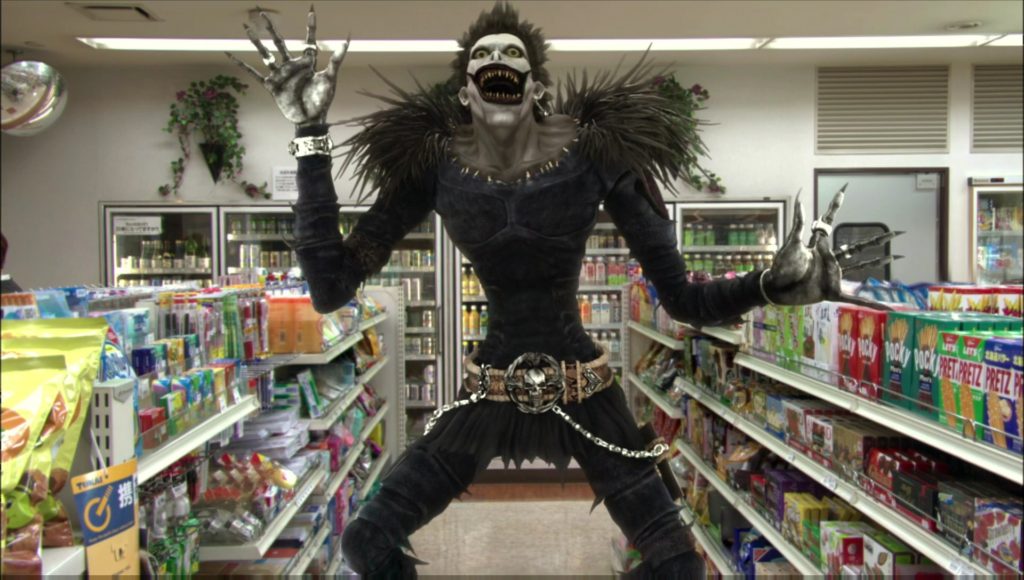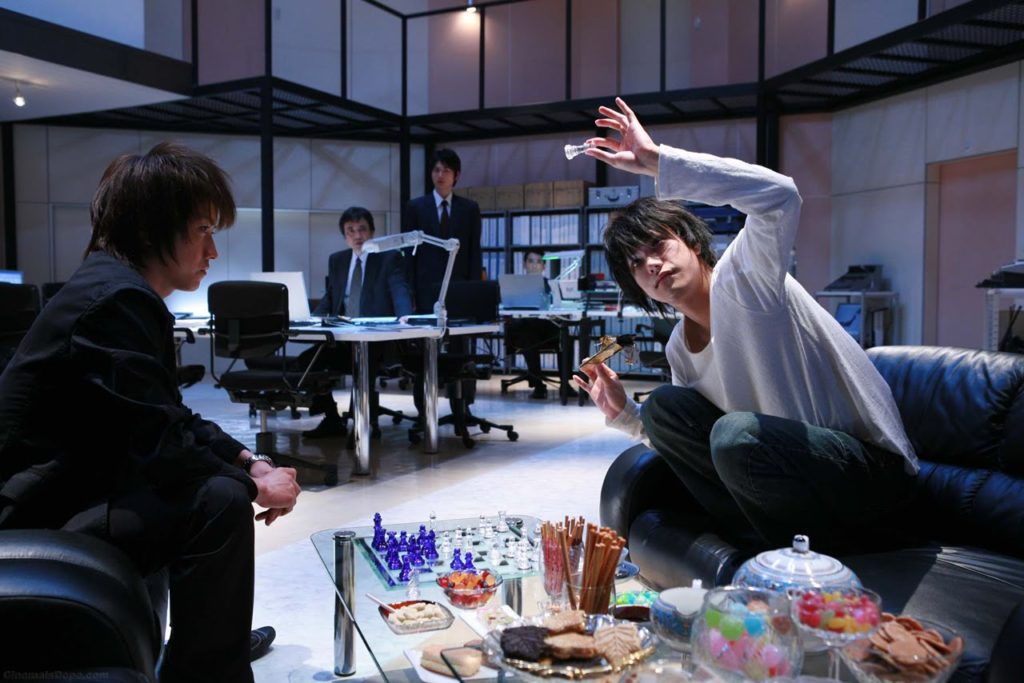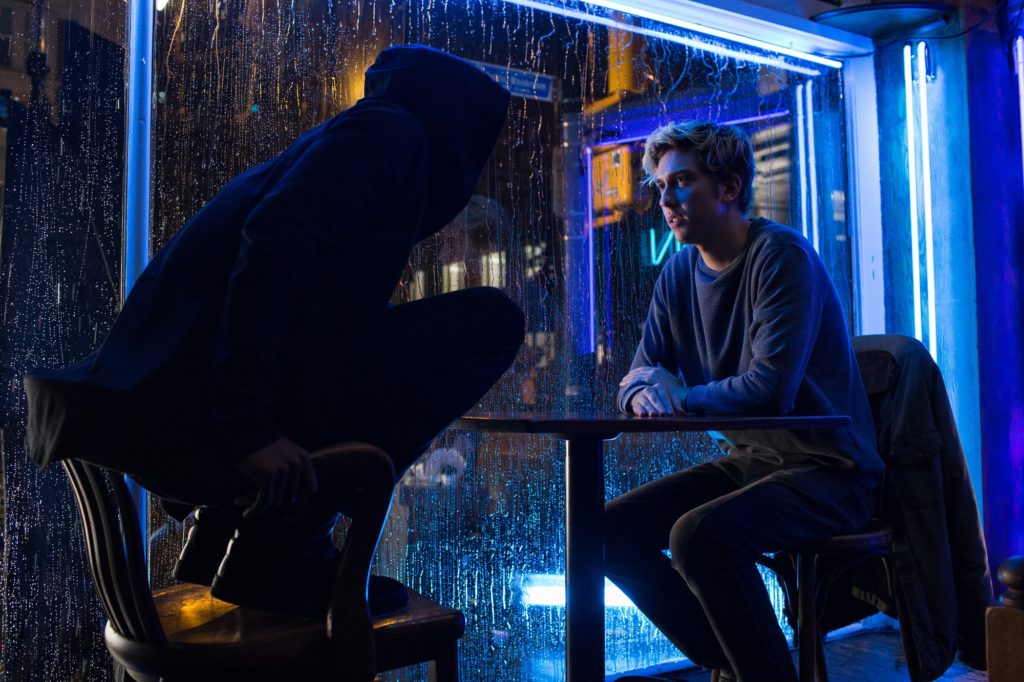
@evilbutters
Adam Wingard’s American live-action version of Death Note based on the original manga by Tsugumi Ohba and Takeshi Obata was just released to Netflix last week, but in addition to the 37 episode anime series the source material was also adapted into four live-action Japanese films (the most recent was released in 2016) and a three-episode live-action TV series that bridged the decade long gap between Death Note II: The Last Name and Death Note: Light Up the New World. But before divulging into how weak the new Death Note is it’s time to look back on the forgotten time of 2006 at the many ups and downs of the weirdness of the first two Japanese live-action films!
Directed by Shusuke Kaneko (Gamera: Guardian of the Universe, Godzilla Mothra and King Ghidorah: Giant Monsters All-Out Attack!) with a screenplay by Tetsuya Oishi (Takashi Miike’s Blade of the Immortal), Death Note and Death Note II: The Last Name are like tiny nuggets of gold wrapped in multiple layers of steamy, hot piles of garbage. In these films, the default death method if you don’t write a cause of death in the Death Note is a heart attack. People are having heart attacks left and right, but everyone overacts in these films so it looks like they’re re-enacting the “nausea, heartburn, indigestion, upset stomach, diarrhea” sickness dance from those Pepto Bismol commercials nobody remembers or cares about.

These films added characters that weren’t in the anime. Light’s parents are both alive and well and he has a sister that is mostly pointless. Light has a girlfriend named Shiori Akino and Misa Amane is a reality television host and accidental music artist. Light is also in college where he studies law and makes money by betting on basketball games he actually plays in. He is already in possession of the Death Note at the beginning of the film and has found a way to hack into the criminal database to research those who faced little to no repercussions for their crimes; something that surely ties into his dad being the chief of police. Ryuk has wings and is able to fly while the English dub track of the film seems to have raided Ocean’s dub of Dragon Ball Z with Brad Swaile (Teen Gohan) voicing Light Yagami, Michael Dobson (Supreme Kai/Nappa) as Rem, and Brian Drummond (Vegeta) stepping in as Ryuk, but this is also the same English cast for the dubbing of the anime series.
For some reason, the Japanese live-action films decided to have the Red Hot Chili Peppers do the theme songs for both adaptations.“Dani California” is the closing theme for the first film, but also the main credits theme in the sequel while “Snow, Hey Oh” is the closing theme for Death Note II. While snow is featured at the very end of the sequel and somewhat ties into that, “Dani California” makes no sense whatsoever to be featured in either film. The computer generated shinigamis or gods of death have not aged well over the past 11 years. The special effects fluctuate from being somewhat passable to coming off as totally outdated. Shading is a key issue with Ryuk and Rem looking out of place thanks to shadows on their body being disproportional with natural sun or moonlight. Motion capture technology and CGI in general progresses so far from year to year, which is why so many films feel dated if they rely and/or heavily feature an element that will drastically change in less than five years.

Adam Wingard’s American version of the film adapted for Netflix feels like the Final Destination franchise and Dawson’s Creek had a regrettable affair together and Death Note is the aborted baby that they attempted to sweep under a back alley dumpster to keep hidden from the rest of the world. While Light still has a father who is a cop, he spends his days doing other student’s homework for money and being incredibly emo as a loner who hides from the world in his dark hoodie and a pair of headphones that blasts drum beat defecation similar to the feces spewing tween wave soundtrack highlighted in the “You’re Getting Old” episode of South Park from season 15.
This version of Death Note depicts Light as a weak individual who seemingly can’t do anything without a girl by his side as a metaphorical set of training wheels. Light basically relies on Mia (the supposed American version of Misa) to be the balls of the operation as they’re essentially killing criminals because they both get off on it, but even he second guesses everything at every turn. The darkness found within the Light character of the anime and Japanese live-action films has been shifted to Mia in the American version while Light is more like Misa; cowering in the face of danger and using the Death Note for the sake of love. In the meantime, you’re subjected to Light’s stupid observations (“Your fingers are huge,”) and trivial dialogue (“I can’t tell you. Do you really want to know? Okay, I’ll tell you,”) along with the film blatantly setting up Mia’s eventual betrayal and Light being the last person in the world to realize it. Light’s string of high-pitched and girlish screams and Ryuk’s inability to eat an entire apple certainly allow you to legitimately facepalm until chafing occurs.
With so many films accused of whitewashing these days, Death Note took the opposite approach when it cast Lakeith Stanfield (Straight Outta Compton, Get Out) as L. While L still can’t sit in a chair properly and has a candy fueled diet that would make a diabetic cat lose all nine of its lives over the course of an hour long period, he’s a vengeful sociopath by the time the film ends which seems completely out of character for him. Wingard has claimed in interviews that his goal was to leave all of the characters damaged at the end of this film, but L is no longer the genius and emotionless detective with unorthodox methods. He’s foaming at the mouth at the thought of murdering Light, which makes you feel like Adam Wingard has done to Death Note what Rob Zombie did to Halloween.

The only good aspect of this new version of Death Note is Willem Dafoe voicing Ryuk. His cackle is so unbelievably entertaining. If the entire 101-minute duration was devoted to Ryuk laughing maniacally then it would have been a much more enjoyable experience. Dafoe has this eerie and raspy grumble to his voice that is perfect for voicing a diabolical god of death who slinks around in the shadows. The unfortunate part is Adam Wingard refuses to let the audience get a clear look at Ryuk throughout the film. He’s never fully revealed in proper lighting. On one hand, this leaves you wanting more of the character so this technique is probably considered fairly successful to the cast and crew of the film. But on the other hand, Ryuk is only in a handful of scenes as it is and it would have been nice that if he couldn’t be around more often then we could have at least had that triumphant and dramatic reveal with a slow pan that started at his feet and crawled to the top of his head like a Godzilla film or something.
The Netflix adaptation of Death Note isn’t unwatchable, but it isn’t satisfying either. However, it’s not like the Japanese films are flawless adaptations either. Unfortunately, Death Note has yet to properly make the jump from manga to the silver screen. The concept is fantastic, but even the anime let that go to waste after the first 13 episodes or so. Uncensored gore and whiny teenage teenage drama fail to captivate not only those who are fans of the source material but are also looking for a decent movie to stream as passable entertainment on a well-earned night off. 2/5 Overrated Kira Worshiping Bibles

